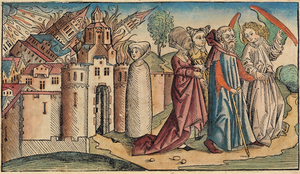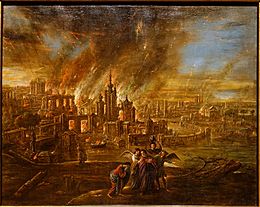Sodom and Gomorrah facts for kids
Sodom and Gomorrah were two biblical cities destroyed by God for their wickedness. They are mentioned frequently in the prophets and the New Testament as symbols of human wickedness and divine retribution, and the Quran also contains a version of the story about the two cities. The narrative of their destruction may have a relation to the remains of third-millennium BCE Bronze Age cities in the region, and subsequent Late Bronze Age collapse.
Biblical narrative

Sodom and Gomorrah are two of the five "cities of the plain" referred in Genesis 13:12 and Genesis 19:29 that rebel against Chedorlaomer of Elam, to whom they were subject. At the Battle of Siddim, Chedorlaomer defeats them and takes many captives, including Lot, the nephew of the Hebrew patriarch Abraham. Abraham gathers his men, rescues Lot, and frees the cities.
Later, God gives advance notice to Abraham that Sodom had a reputation for wickedness. Abraham asks God "Will you sweep away the righteous with the wicked?" (Genesis 18:23). Starting at 50 people, Abraham negotiates with God to spare Sodom if 10 righteous people could be found.
God sends two angels to destroy Sodom. Lot welcomes them into his home.
The angels tell Lot "...the outcry against its people has become great before the Lord, and the Lord has sent us to destroy it" (Genesis 19:13). The next morning, because Lot had lingered, the angels take Lot, Lot's wife, and his two daughters by the hand and out of the city, and tell him to flee to the hills and not look back. Lot says that the hills are too far away and asks to go to Zoar instead. Then God rains sulfur and fire on Sodom and Gomorrah and all the Plain, and all the inhabitants of the cities, and what grew on the ground (Genesis 19:24–25). Lot and his two daughters are saved, but his wife disregards the angels' warning, looks back, and is turned into a pillar of salt.
Historicity
It has been suggested that if the story does have a historical basis, the cities may have been destroyed by a natural disaster. One such idea is that the Dead Sea was devastated by an earthquake between 2100 and 1900 BCE. This might have unleashed showers of steaming tar. It is possible that the towns were destroyed by an earthquake, especially as they lay along a major fault such as the Jordan Rift Valley; however, there are no known contemporary accounts of seismic activity that corroborate this theory, and this and the suggestion that they were destroyed by a volcano have been deemed unlikely.
A 2021 paper in Scientific Reports proposed that the city of Tall el-Hammam had been destroyed by a meteor air burst, and that this may be the origin of Genesis account. A "Matters arising" piece , also in Scientific Reports, argues that the cited evidence is not enough to confirm an impact or airburst.
Possible sites
Archibald Sayce translated an Akkadian poem describing cities that were destroyed in a rain of fire and written from the view of a person who escaped the destruction; unfortunately, the names of the cities are not given in the work. Sayce later mentions that the story more closely resembles the doom of Sennacherib's host.
The ancient Greek historiographer Strabo states that locals living near Moasada (as opposed to Masada) say that "there were once thirteen inhabited cities in that region of which Sodom was the metropolis". Strabo identifies a limestone and salt hill at the southwestern tip of the Dead Sea, and Kharbet Usdum (Hebrew: הר סדום, Har Sedom or Arabic: جبل السدوم, Jabal(u) 'ssudūm) ruins nearby as the site of biblical Sodom.
The Jewish historian Josephus identifies the Dead Sea in geographic proximity to the ancient biblical city of Sodom. He refers to the lake by its Greek name, Asphaltites.
In 1973, Walter E. Rast and R. Thomas Schaub discovered or visited a number of possible sites of the cities, including Bab edh-Dhra, which was originally excavated in 1965 by archaeologist Paul Lapp, and later finished by Rast and Schaub following Lapp's death. Other possibilities include Numeira, al-Safi, Feifa (or Fifa, Feifah), and Khirbet al-Khanazir, which were also visited by Schaub and Rast. According to Schaub, Numeira was destroyed in 2600 BCE at a different time period than Bab edh-Dhra (2350–2067 BCE).
In 1993 Nancy Lapp, from the Pittsburgh Theological Seminary, reported that Feifa had no Bronze Age occupation and merely an Early Bronze Age cemetery with Iron Age walls. She reports:
In the final season of the present series of excavations of the Expedition to the Dead Sea Plain (1990–1991), the walled site of Feifa was investigated and the EB [Early Bronze Age] cemetery that stretched to its east was excavated. The most recent surveys suggested that the visible structures of the walled site belonged to the Iron Age or Roman period.
At Khirbet al-Khanazir, the walls which Rast and Schaub had identified in 1973 as houses were in reality rectangular charnel houses marking shaft tombs from near the end of the Early Bronze Age and not occupational structures.
In 1976, Giovanni Pettinato claimed that a cuneiform tablet that had been found in the newly discovered library at Ebla contained the names of all five of the cities of the plain (Sodom, Gomorrah, Admah, Zeboim, and Bela), listed in the same order as in Genesis. The names si-da-mu [TM.76.G.524] and ì-ma-ar [TM.75.G.1570 and TM.75.G.2233] were identified as representing Sodom and Gomorrah, which gained some acceptance at the time. However, Alfonso Archi states that, judging from the surrounding city names in the cuneiform list, si-da-mu lies in northern Syria and not near the Dead Sea, and ì-ma-ar is a variant of ì-mar, known to represent Emar, an ancient city located near Ebla. Today, the scholarly consensus is that "Ebla has no bearing on ... Sodom and Gomorra."
See also
 In Spanish: Sodoma y Gomorra para niños
In Spanish: Sodoma y Gomorra para niños
- Bab edh-Dhra and Numeira, two adjacent archeological sites said by some to be the two cities' locations


